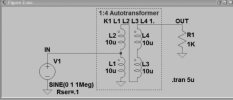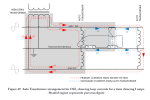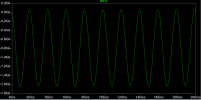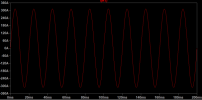kp_raileng
New Member
Hello,
I am looking to model an ATF system using LT spice, however I am having trouble setting up a reliable system: I have modelled the centre tapped transformer as two 25 kV (peak) 50 Hz AC Voltage sources with a 180 degree phase shift; the Inductors (used to represent the Auto transformers) as 0.2 H; The train as a resistive load of 80 Ohm. The issue is when I check the current in the Voltage sources, I am getting 800 A peak. This is far greater than the current in the resistive load, which reads 300 A.
1. I would like to know whether anyone is able to give any advice as to whether I can make any improvements with my model to yield more realistic results.
2. I am also aware that Lt Spice is typically used for lower voltage electronics modelling. Is anyone able to recommend a similar free (and new user friendly) application that may be more suited to high voltage circuit modelling?
Please see the attached images for reference.
Circuit Diagram Voltage across resistive load (i.e. train) Current across resistive load
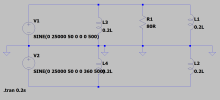
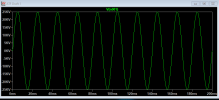
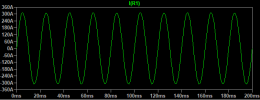
Many Thanks.
I am looking to model an ATF system using LT spice, however I am having trouble setting up a reliable system: I have modelled the centre tapped transformer as two 25 kV (peak) 50 Hz AC Voltage sources with a 180 degree phase shift; the Inductors (used to represent the Auto transformers) as 0.2 H; The train as a resistive load of 80 Ohm. The issue is when I check the current in the Voltage sources, I am getting 800 A peak. This is far greater than the current in the resistive load, which reads 300 A.
1. I would like to know whether anyone is able to give any advice as to whether I can make any improvements with my model to yield more realistic results.
2. I am also aware that Lt Spice is typically used for lower voltage electronics modelling. Is anyone able to recommend a similar free (and new user friendly) application that may be more suited to high voltage circuit modelling?
Please see the attached images for reference.
Circuit Diagram Voltage across resistive load (i.e. train) Current across resistive load



Many Thanks.

